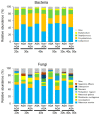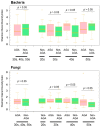Scalp Microbiome and Sebum Composition in Japanese Male Individuals with and without Androgenetic Alopecia
- PMID: 34683453
- PMCID: PMC8536999
- DOI: 10.3390/microorganisms9102132
Scalp Microbiome and Sebum Composition in Japanese Male Individuals with and without Androgenetic Alopecia
Abstract
The skin microbiome and sebum may be associated with inflammation-related diseases of the scalp. To assess the pathogenesis and progression of androgenetic alopecia (AGA), we analyzed the composition of sebum and the bacterial and fungal microbiomes of the scalps of 118 Japanese male individuals with and without AGA, then discussed their roles in the pathogenesis of AGA. Sebum triglyceride and palmitic acid contents were higher in the AGA group than in the non-AGA group. Malassezia restricta, a lipophilic fungus that consumes palmitic acid, was abundant on the scalps of patients with AGA. Cutibacterium, Corynebacterium, and Staphylococcus were the most common genera in both groups, and patients with AGA exhibited scalp dysbiosis (increased abundance of Cutibacterium and decreased abundance of Corynebacterium). Our findings suggest that both sebum and the bacterial and fungal microbiomes of the scalp may be involved in the development of AGA.
Keywords: Malassezia; androgenetic alopecia; microbiome; scalp; sebum composition.
Conflict of interest statement
K.S., M.I., R.M., Y.S. and T.N. are employees of Taisho Pharmaceutical Co., Ltd. (Tokyo, Japan).
Figures





References
-
- Takashima I., Iju M., Sudo M. Alopecia androgenetica—Its incidence in Japanese and associated conditions. In: Orfanos C.E., Montagna W., Stüttgen G., editors. Hair Research. Springer; Berlin, Germany: 1981. pp. 287–293.
LinkOut - more resources
Full Text Sources
Other Literature Sources
Miscellaneous

